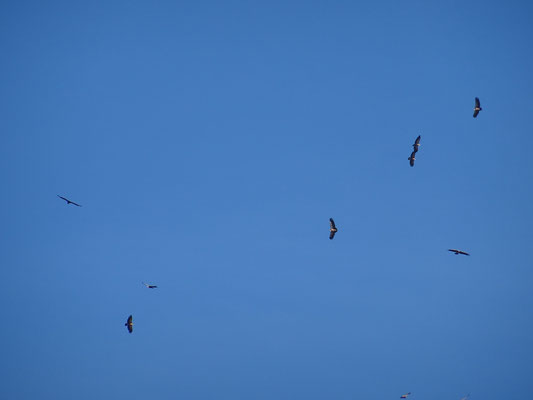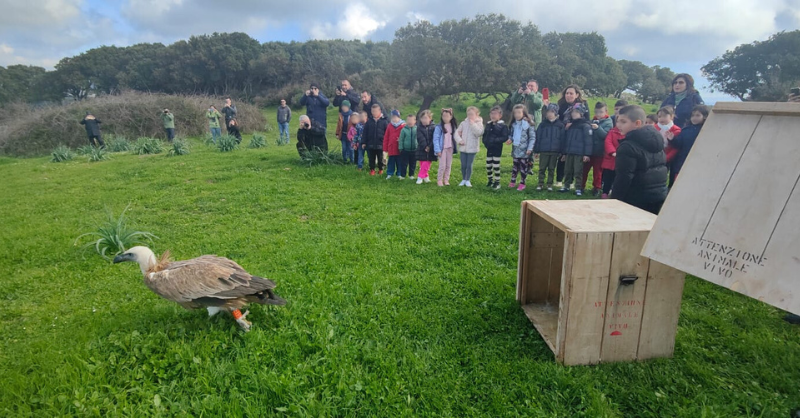
The Griffon Vulture population in the Eastern Rhodopes sustains its positive growth for yet another year as more than 100 pairs were recently recorded within the scope of LIFE Re-Vultures.
Ongoing Griffon Vulture breeding season in the Eastern Rhodopes
Experts from the Bulgarian Society for the Protection of Birds (BSPB) counted a total of 107 Griffon Vulture pairs during the regular monitoring of the species’ population along the Arda River valley in the Eastern Rhodopes. The number will likely increase in the coming months as several more nests remain to be inspected. The current number of established pairs that have started to breed is 75, while the rest of the pairs are either repairing or building their nests. As the breeding season progresses, the LIFE Re-Vultures teams will better determine the exact number of breeding pairs, including those that will not be laying eggs this year. Regarding the Greek part of the Eastern Rhodopes, information will soon be made available by our colleagues from WWF Greece.
Special breeding moments of tagged Griffon Vultures
Some of the Griffon Vultures tracked with GPS tags have already occupied their nests and laid their clutches. For Buria (Storm) this will be the fifth nesting season since the bird was equipped with a tag and so far has successfully raised three young. Krum is another experienced parent, closely followed by the project for 5 years now. He has so far raised four chicks and this year has taken a new nest near the dam Studen Kladenets. Furthermore, BSPB observed for the first time a pair of two Griffon Vultures marked by the project team – 4V and 3G. The birds are not equipped with GPS tags and have so far had unsuccessful attempts to breed with other partners. We hope that they will now be successful in raising a chick for the first time.
Аnother interesting story is the one of Dionysus, a Griffon Vulture nesting in the Greek part of the Rhodopes. Last year, he demonstrated dedication and sacrifice. After losing his mate during the hatching period, he spent 33 days without eating, tirelessly caring for the egg. In the end, Dionysus failed to raise the little one, but he proved to us once again the devotion of vulture parents. This year, Dionysus decided to take a break from his parental duties, although he and his new partner are building comfortable ‘apartments’ on several different rocks.
Griffon Vultures in Bulgaria’s Rhodope Mountains
The Griffon Vulture was once widely distributed across Bulgaria. In the early 1970s, the species was thought to be extinct, mainly due to the decreasing availability of food, habitat loss, persecution and poisoning. Surprisingly, in 1986 locals discovered a small Griffon Vulture colony near the small town of Madzharovo in the Eastern Rhodope Mountains, consisting of about 20 birds and three nesting pairs. Then, conservationists launched the first direct activities for the conservation of the remaining Griffon Vultures in Bulgaria. They have been working for many years to improve natural food availability and reduce mortality by tackling poaching, poisoning, and collisions with power lines to support the comeback of these birds. As a result of ongoing conservation efforts, the species is gradually recovering and today the Arda River Valley hosts one of the largest natural colonies of Griffon Vultures in the Balkans.
LIFE RE-Vultures

Starting in 2016, the five-year LIFE RE-Vultures project was developed by Rewilding Europe, in collaboration with the Rewilding Rhodopes Foundation the Bulgarian Society for the Protection of Birds, WWF Greece, the Hellenic Ornithological Society and us here at the Vulture Conservation Foundation. The aim of the project is to support the recovery and further expansion of the populations of Cinereous and Griffon Vultures in the cross-border region of the Rhodope Mountain by improving natural prey availability, monitoring movements of birds to help understand the threats they face and carrying out activities that will reduce the mortality of the populations from threats such as illegal wildlife poisoning and collisions with electricity infrastructure.






